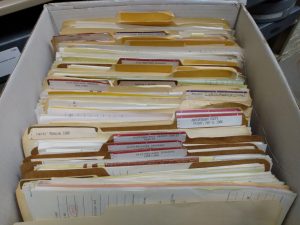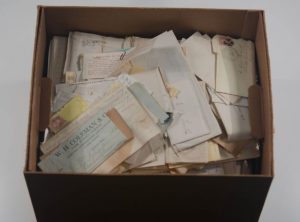By Susan Martin, Senior Processing Archivist
The Massachusetts Historical Society is well-known for its colonial, Revolutionary War, early presidential, and Civil War collections. But did you know that we collect up to the present day?
The MHS’s modern collections (dating from the late 20th and early 21st centuries) are usually larger—sometimes much larger—than older collections. For example, the Massachusetts Audubon Society records fill 121 record cartons, 11 document boxes, and 5 oversize boxes. The records of the ACLU of Massachusetts take up nearly 100 cartons and more. And because both organizations are still operating, we expect future deposits. With a permanent processing team of only 3 ½ people, you can imagine how hard it is to stay on top of all the material we acquire.
In order to process large modern collections, reduce the backlog, and make papers available to researchers more quickly, MHS archivists have been selectively implementing the “more product, less process” (MPLP) approach. MPLP dates back to an article by Mark A. Greene and Dennis Meissner published in The American Archivist in 2005. Greene and Meissner advocated for minimal processing where possible to provide faster access to more collections.
Traditional processing is very time-consuming. It usually involves arranging individual pieces of paper in chronological order, removing metal fasteners, replacing folders, relabeling folders, and other tasks intended to help researchers find what they’re looking for and to preserve papers for the long term. However, too many collections end up sitting in storage because we simply don’t have the time or staff to process them at this level.
According to Greene and Meissner, if a collection arrives at a repository in decent condition and reasonably well organized, archivists should be able to make it available in a fraction of the time. For example, take this carton of papers that came to the MHS well-arranged and identified.

Some labels have fallen off, some folders are overstuffed, and related materials are separated and out of sequence, but with minimal work, this collection could be given to a researcher in a matter of days, rather than weeks, months, or even years. We might retain the original folders, move some of them around, write up a folder list, and voila!
I’m very happy to highlight a number of collections that were part of the MHS backlog for some time, but have now been made available thanks to MPLP. These include the Americans for Democratic Action, Massachusetts Chapter records (acquired in 1976); the Pan American Society of New England records (acquired in 2000); and the Ben and Jane Thompson Faneuil Hall Marketplace records (acquired in 2003 and 2005). We’ve also applied MPLP principles to newly acquired collections so they’re never added to the backlog at all, such as the Ticknor Society records (acquired earlier this year).
There are some legitimate concerns about the use of MPLP in archives. First, modern records often contain personally identifiable information (PII), such as social security numbers, and other private data on living people. Archivists are bound by law and professional ethics to protect individuals who may be harmed by information in our collections. We remove or redact PII from all collections, regardless of processing level.
Second, while rusty staples and paper clips and acidic newspaper clippings do damage papers, the most important intervention for long-term preservation is temperature and humidity control. Under cool and dry conditions, a collection can be stabilized and protected from further deterioration, even in less-than-ideal enclosures.
Lastly, MPLP works best with organizational records, but less well with collections of personal or family papers, especially the ones that come to us looking like this!

Archivists at the MHS are piloting various approaches and running time trials, and these techniques will continue to be assessed. Processing methods range along a spectrum from minimal to comprehensive, and each collection has different needs. The “more product, less process” approach not only buys us time, so that we can return to a collection later if necessary, but also allows us to make as much material as possible available to our researchers right now.

